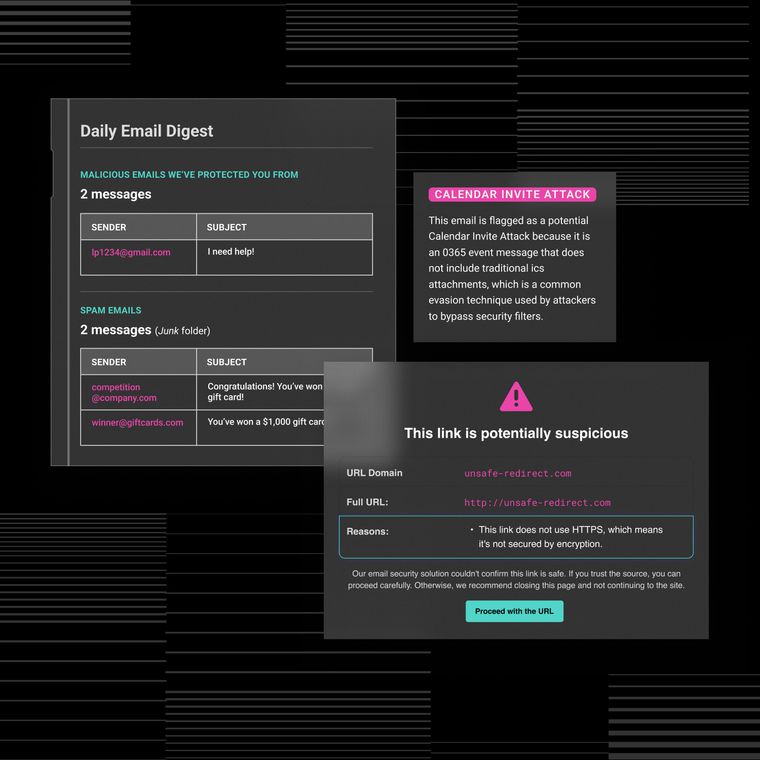DSPM Explained: 3 Ways Data Security Posture Management Protects Your Assets
Understand how data security posture management (DSPM) protects critical data assets.
July 20, 2025
Data Security Posture Management (DSPM) protects your data wherever it resides, before attackers can access it. As workloads migrate to SaaS applications, multi-cloud services, and on-premises systems, sensitive personal information spreads across thousands of locations, each a potential entry point for a phishing link or a privilege-escalation exploit.
DSPM solves this through three core capabilities: comprehensive visibility that automatically finds and classifies every dataset across cloud buckets, SaaS drives, and legacy file shares; continuous risk assessment that surfaces misconfigurations and excessive permissions the moment they appear; and automated remediation that revokes unnecessary access or encrypts exposed files, so you know exactly what to do after a phishing attack or email spoofing compromises an account.
The sections that follow examine each capability in depth, showing how DSPM reduces breach risk, streamlines compliance, and frees your team to focus on strategy rather than searching for lost data.
1. Comprehensive Visibility and Inventory
DSPM provides real-time visibility into sensitive data across your infrastructure using automated discovery and AI-driven classification. It scans cloud services, on-premises databases, and SaaS apps via API connections, identifying both structured and unstructured data quickly. As new data assets emerge, the system updates continuously, eliminating the gaps identified in traditional audits.
AI-driven classification adds context to the data, recognizing sensitive information such as PCI card numbers or contract clauses and tagging it based on its sensitivity and relevant regulatory requirements. This allows for quick filtering, such as finding "all unencrypted PII in Europe" or "HIPAA datasets shared with third-party vendors," simplifying compliance reporting.
Data lineage mapping tracks how customer records are moved between systems, identifying orphaned files or shadow data created by backups or test environments, as well as common security risks. With DSPM, compliance managers can easily access a real-time overview of all data, its owner, and protection status, making audits smoother and more efficient.
This ongoing visibility not only streamlines data oversight but also significantly reduces the risk of data breaches.
2. Continuous Risk Assessment and Monitoring
Continuous risk assessment and monitoring enable you to see, score, and address data exposure in real-time, preventing misconfigurations or excessive permissions from escalating into incidents.
When every new cloud bucket, database, or SaaS workspace can hold sensitive records, point-in-time audits fail. Point-in-time audits that depend on static email archiving exports are obsolete the moment they’re generated.
A DSPM platform never stops watching. It inventories each data store and immediately analyzes its posture, including encryption state, sharing settings, public exposure, and inherited permissions against your policies. Findings are risk-scored, allowing your team to focus on issues that could enable credential phishing rather than low-impact misconfigurations.
Automated Detection Capabilities
DSPM detects security issues through integrated techniques. Automated scans reveal misconfigurations, such as publicly accessible storage or unencrypted backups. Permission analytics flag users violating least-privilege principles, reducing the blast radius of targeted attacks. By correlating IAM data with sensitivity tags, DSPM highlights high-risk identities to fix first.
For instance, behavioral models track access baselines and alert when credentials suddenly download gigabytes of regulated data at odd times. Encryption checks verify sensitive datasets remain protected, linking gaps to compliance controls.
Real-Time Risk Prioritization
Organizations can instantly identify critical data risks, such as legacy S3 buckets containing sensitive customer records with overly permissive access policies. The platform automatically prioritizes such vulnerabilities, enabling security teams to revoke risky policies within minutes, effectively closing breach windows that could otherwise remain open for extended periods.
Every change to data location or policy is assessed immediately, with dashboards updating automatically to provide real-time compliance views against regulations like GDPR, HIPAA, or PCI-DSS. Security leaders receive live heat maps highlighting top-risk assets, while compliance managers can export evidence at any time.
Continuous monitoring transforms data posture management from reactive auditing into proactive safeguarding. Sensitive records remain encrypted, permissions stay tightly controlled, and any deviations are detected and often remediated before attackers can exploit them.
3. Automated Remediation and Policy Enforcement
By connecting to cloud APIs, identity systems, and data stores, DSPM rapidly detects exposures and alerts administrators, enabling them to revoke excessive permissions, encrypt or quarantine exposed data, reset risky configurations, and enforce written policies more efficiently. DSPM’s automated enforcement also complements security awareness training by ensuring that human errors are identified and corrected in real-time.
How Automated Remediation Works
Once discovery and classification are in place, the platform evaluates each finding against a rules engine that maps to frameworks such as GDPR, HIPAA, or PCI-DSS. When a violation is detected, such as a public S3 bucket containing payroll data, then the system immediately removes the public ACL, forces encryption, and updates the audit log without waiting for an analyst.
This direct API integration streamlines traditional ticket-based workflows, enabling immediate action and reducing the dwell time of sensitive data exposure from days to hours.
Balancing Speed and Control
You decide how aggressive the system should be. Low-impact fixes, such as tightening a misconfigured storage policy, can be run without manual approval, while high-impact changes require sign-off from a human.
This mix of automated and human-in-the-loop responses keeps workflows fast but controlled, critical when attackers use tactics like MFA fatigue attacks to bombard users with approval requests.
Operational Impact and Limitations
The operational benefits of DSPM are immediate and measurable. Organizations managing thousands of network devices can replace manual rule reviews with automated policy enforcement, achieving full regulatory compliance across all locations while gaining real-time visibility into every security policy.
By automating routine checks and fixes, security teams reclaim hours of repetitive work and enter audits with evidence already prepared.
Automation requires careful implementation. Overzealous revocation can disrupt legitimate workflows, and machine learning models continue to mislabel edge-case data. You need guardrails, such as role-based approval paths, granular rollback, and continuous policy tuning, to prevent disruption.
Yet even with those safeguards, the balance tilts in your favor: security teams focus on architecture and threat hunting rather than manual cleanup, and compliance managers walk into assessments with provable, continuous enforcement logs.
Elevate Your Security Posture with DSPM
Data Security Posture Management (DSPM) enhances the protection of sensitive assets through three key strengths: comprehensive visibility, continuous risk assessment, and automated remediation. By centering defenses on the data itself, rather than on infrastructure alone, DSPM closes gaps that legacy controls overlook.
As data estates grow, DSPM moves from optional to essential. Teams that deploy these platforms cut breach risk, accelerate compliance, and reclaim hours lost to manual policy enforcement. Automated, data-centric controls keep analysts focused on strategy and threat hunting, rather than routine cleanup.
Benchmark your current program against DSPM capabilities by asking whether you can track every data store in real time, continuously score and prioritize risk, and automatically roll back risky permissions when they appear.
If not, DSPM provides the holistic, insight-driven posture required for today’s threat landscape. Data-centric security is the future of cyber defense. Adopting DSPM now ensures you stay ahead while safeguarding what matters most, which is your data. Book a demo today to learn how Abnormal’s AI-powered platform delivers continuous data visibility, real-time risk scoring, and automated remediation to elevate your security posture.
Related Posts
Get the Latest Email Security Insights
Subscribe to our newsletter to receive updates on the latest attacks and new trends in the email threat landscape.


